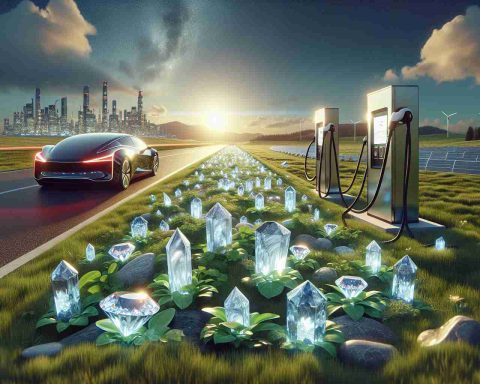Reviving the Energy Industry
In a striking return to his economic strategies, President Trump has taken decisive action on his first day back in office, signing a series of executive orders aimed at transforming America’s energy landscape. These orders signal a strong commitment to drastically reduce regulatory barriers and enhance energy production across the nation.
Central to Trump’s economic focus is a renewed emphasis on energy policies, where he swiftly negated several regulations put in place by the previous administration that limited oil leasing. His administration is set on fostering increased output from traditional energy sources while also setting ambitious targets for electric vehicle production.
Highlighting the connection between energy production and inflation, Trump expressed that prior energy policies have negatively impacted the economy, asserting the need for a robust energy sector to drive down costs. With a clear plan aimed at revitalizing the economy, Trump indicated that these actions are fundamental to alleviating the cost of living crisis faced by many Americans.
To further address inflation, he activated an executive order calling for a comprehensive government response to tackle rising living costs. Administration officials emphasized that these moves are crucial for reducing prices swiftly and effectively, aligning with Trump’s goal to put America back on a path toward prosperity.
Broader Implications of Energy Revitalization
The return to aggressive energy policies under President Trump has profound implications for society and the global economy. By prioritizing fossil fuels over renewable sources, the U.S. risks entrenching its position within traditional energy frameworks while sidelining innovative sustainable solutions. This shift may exacerbate climate change, which remains a daunting global challenge. As larger economies push toward net-zero goals, the U.S.’s retrenchment could undermine international collaborations aimed at environmental protection.
Moreover, the immediate impact on job sectors is noteworthy. While Trump’s policies may generate employment in traditional energy sectors, such as coal and oil, they do little to address the burgeoning renewable energy market—an area projected to create millions of jobs. According to the International Renewable Energy Agency (IRENA), the transition to renewable energy could enable the creation of up to 24 million new jobs worldwide by 2030.
The societal impact also extends to health outcomes tied to environmental quality. Increased reliance on fossil fuels may exacerbate air pollution, leading to greater health risks, particularly for vulnerable populations. This intersection of energy policy and public health is critical; studies suggest that fossil fuel-related air pollution causes thousands of premature deaths annually in the U.S. alone.
Looking ahead, future trends indicate that global energy demands are shifting. The International Energy Agency (IEA) reports a significant increase in electric vehicle adoption, with projections suggesting that by 2030, nearly 30% of cars sold worldwide could be electric. Trump’s energy policies may momentarily boost traditional sectors, but failing to pivot toward innovation could leave the U.S. lagging behind in the global energy transition, which is not just a necessity for the environment but also a critical component of economic competitiveness.
Trump’s Bold Energy Strategy: Revolutionizing America’s Future
Reviving the Energy Industry
On his first day back in office, President Trump has made a significant impact on the energy sector with a series of executive orders designed to reshape America’s approach to energy production. These initiatives represent a strategic pivot towards deregulation, aiming to enhance energy output and reduce costs related to living expenses and inflation.
Key Features of Trump’s Energy Policies
1. Deregulation of Energy Leasing: Trump has swiftly rolled back regulations from the former administration that constrained oil and gas leasing. This move is anticipated to invigorate the fossil fuel sector, allowing increased access to national resources.
2. Focus on Electric Vehicles (EVs): In addition to traditional energy sources, the current administration is setting ambitious targets aimed at ramping up the production of electric vehicles. This reflects a dual strategy of enhancing energy supply while pushing for greener alternatives.
3. Economic Link: Trump’s policies underscore a strong connection between energy production and national economic health. By asserting that prior energy regulations contributed to inflation, his administration positions the energy sector as a crucial player in economic recovery efforts.
Pros and Cons of the New Energy Strategy
Pros:
– Increased Energy Production: Easing regulations may lead to a surge in domestic energy output, potentially lowering prices at the consumer level.
– Job Creation: The push for energy development, including fossil fuels and electric vehicle production, may stimulate job growth in these sectors.
– Economic Recovery Focus: The strategy aims to stabilize the economy by directly addressing the cost of living concerns affecting many Americans.
Cons:
– Environmental Concerns: Aggressive expansion of fossil fuel production can raise significant environmental issues, including pollution and climate change impacts.
– Long-Term Sustainability: A strong focus on traditional energy sources may hinder investments in renewable energy technologies.
– Public Resistance: There may be pushback from environmental groups and communities advocating for sustainable energy practices.
Trends and Innovations in the Energy Sector
The current administration’s energy policies reflect broader trends in the industry, where a balance between traditional and renewable energy sources is increasingly sought. Innovations in clean energy technologies and infrastructure, as well as policies supporting a sustainable transition, will be essential for future competitiveness and environmental responsibility.
Predictions for the Future of Energy in America
Market analysts predict that a resurgence in traditional energy production could lead to a temporary alleviation of inflation; however, long-term economic stability will likely depend on the integration of renewable energy solutions. As electric vehicle usage grows, the administration’s commitment to this area will be a defining factor in reducing carbon footprints and meeting global climate agreements.
Conclusion
Trump’s renewed energy strategy represents a bold approach to reshaping the energy landscape in America. By focusing on deregulation and boosting production across various sectors, the administration aims to address immediate economic challenges while navigating the complex path towards sustainable energy practices. The effectiveness of these policies will be evaluated in the coming months as their impacts on inflation and job growth begin to unfold.
For more information on energy practices and policies, you can visit Energy.gov.












